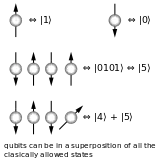Parity measurement
Parity measurement (also referred to as Operator measurement) is a procedure in Quantum information science that is used to project a state into an eigenstate of an operator and to acquire its eigenvalue.[1] For example, given a Hermitian and Unitary operator (whose eigenvalues are ) and a state , the circuit on the top right performs a Parity measurement on . After the first Hadamard gate, the state of the circuit is

Quantum circuit that exhibits Parity measurement
After applying the controlled-U gate, the state of the circuit evolves to
After applying the second Hadamard gate, the state of the circuit turns into
If the state of the top qubit after measurement is , then ; which is the eigenstate of . If the state of the top qubit is , then ; which is the eigenstate of . [2]
References
- Gottesman, Daniel (2009). "An Introduction to Quantum Error Correction and Fault-Tolerant Quantum Computation". arXiv:0904.2557.
{{cite journal}}: Cite journal requires|journal=(help) - Devitt, Simon J.; Nemoto, Kae; Munro, William J. (2009). "Quantum Error Correction for Beginners". arXiv:0905.2794.
{{cite journal}}: Cite journal requires|journal=(help)
This article is issued from Wikipedia. The text is licensed under Creative Commons - Attribution - Sharealike. Additional terms may apply for the media files.

